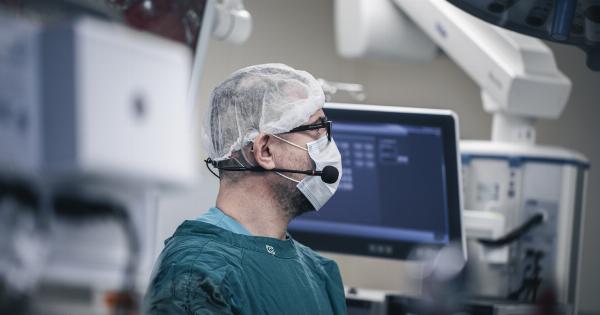A hernia is a medical condition that occurs when an internal organ or tissue pushes through a weak spot or tear in the surrounding muscle or connective tissue.
This can result in a visible bulge or protrusion, and is often accompanied by pain or discomfort.
Types of Hernias
There are several different types of hernias that can occur in various parts of the body. Here are some of the most common ones:.
1. Inguinal Hernias
Inguinal hernias are the most common type, accounting for approximately 70% of all hernias. They occur in the groin area when part of the intestine or the bladder protrudes through the abdominal wall. Inguinal hernias are more common in men than women.
2. Femoral Hernias
Femoral hernias also occur in the groin area, but lower down near the thigh. They are more common in women and tend to be smaller than inguinal hernias.
3. Umbilical Hernias
Umbilical hernias are often seen in infants, but they can also occur in adults. They happen when part of the intestine protrudes through the abdominal wall near the belly button.
These hernias are more common in women, especially those who have been pregnant.
4. Incisional Hernias
Incisional hernias occur at the site of a previous surgical incision. They can develop months or even years after the surgery, and often result from the weakened area in the abdominal wall where the incision was made.
5. Hiatal Hernias
Hiatal hernias are different from the other types mentioned above. They occur when part of the stomach pushes through the diaphragm into the chest cavity. Hiatal hernias can cause symptoms such as heartburn, chest pain, and difficulty swallowing.
Causes of Hernias
Hernias can have various causes, including:.
1. Weakness in the Abdominal Wall
One of the main causes is a weakness in the abdominal wall, which may be present from birth or develop over time due to aging, obesity, or strenuous physical activity.
2. Muscle Strain
Lifting heavy objects, chronic coughing or sneezing, and straining during bowel movements can also put strain on the abdominal muscles and increase the risk of hernias.
3. Pregnancy
Pregnancy can put extra pressure on the abdomen, leading to the development of hernias in some women.
4. Previous Surgical Incisions
If a previous surgical incision doesn’t heal properly or weakens over time, it can create an opening for a hernia to develop.
Symptoms of Hernias
The symptoms of a hernia can vary depending on the type and location. Common symptoms include:.
1. Visible Bulge or Lump
A visible bulge or lump is often the most noticeable symptom of a hernia. It may become more visible when standing, coughing, or straining.
2. Pain or Discomfort
Many hernias cause pain or discomfort, especially when lifting heavy objects, bending over, or coughing. The pain may improve when lying down or gently pushing the hernia back into place.
3. Weakness or Pressure
Some people with hernias may experience a feeling of weakness or pressure in the affected area.
4. Acid Reflux or Difficulty Swallowing
In the case of hiatal hernias, symptoms may include acid reflux (heartburn) or difficulty swallowing.
Treatment Options
The treatment for hernias varies depending on the severity and type of hernia. Here are some common treatment options:.
1. Watchful Waiting
In some cases, especially for small hernias that are not causing symptoms, a doctor may recommend a watchful waiting approach. This means monitoring the hernia and only opting for treatment if it becomes more problematic or symptoms worsen.
2. Lifestyle Changes
In cases where obesity or poor muscle tone contribute to the hernia, making certain lifestyle changes such as weight loss, regular exercise, and avoiding straining activities may help alleviate symptoms or prevent the hernia from getting worse.
3. Hernia Trusses or Belts
Hernia trusses or belts are supportive undergarments designed to keep the hernia in place. However, they are typically considered a temporary solution and may not be suitable for all types or sizes of hernias.
4. Surgical Repair
In most cases, surgical repair is the recommended treatment for hernias. The surgery involves pushing the protruding organ or tissue back into place and reinforcing the weakened area with stitches or a synthetic mesh.
Surgical repair can be done through open surgery or minimally invasive techniques, such as laparoscopy.
Recovery and Prognosis
The recovery period and prognosis for hernia repair surgery depend on various factors, including the type and size of the hernia and the individual’s overall health.
In general, most people are able to resume their normal activities within a few weeks following surgery, but it may take several months for a full recovery.
Prevention
While hernias cannot always be prevented, there are steps you can take to reduce your risk:.
1. Maintain a Healthy Weight
Excess weight puts strain on the abdominal muscles, increasing the risk of hernias. Maintaining a healthy weight through a balanced diet and regular exercise can help reduce this risk.
2. Lift Objects Properly
When lifting heavy objects, remember to use your legs, not your back, to minimize strain on the abdominal muscles.
3. Avoid Straining
Avoid activities that involve excessive straining, such as chronic coughing or constipation, as these can weaken the abdominal muscles.
4. Strengthen Your Core Muscles
Regular exercise targeting the core muscles can help strengthen the abdominal wall, reducing the risk of hernias.
























